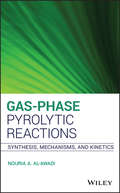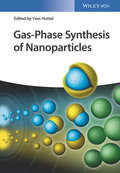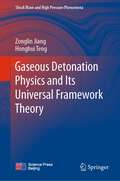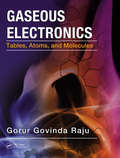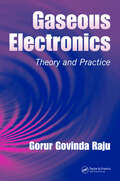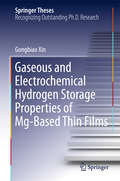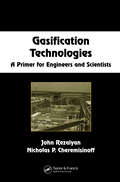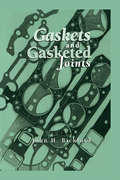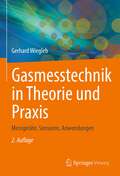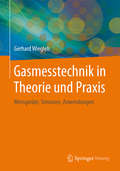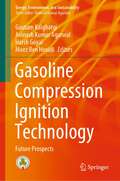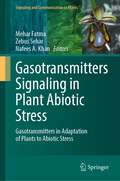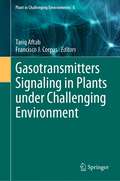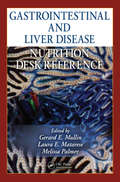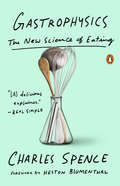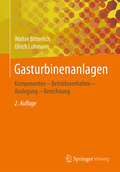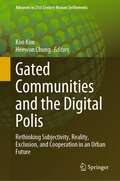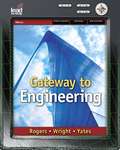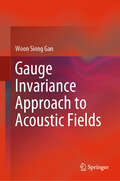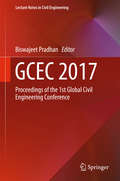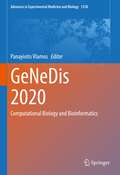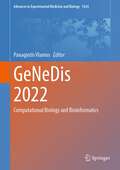- Table View
- List View
Gas-Phase Pyrolytic Reactions: Synthesis, Mechanisms, and Kinetics
by Nouria A. Al-AwadiOffers a physical organic chemistry and mechanistic perspective of the chemistry of thermal processes in the gas phase The book looks at all aspects of the chemical processing technique called gas-phase pyrolysis, including its methodology and reactors, synthesis, reaction mechanisms, structure, kinetics, and applications. It discusses combinations of pyrolytic reactors with physiochemical techniques, routes for and reactions for the synthesis of organic compounds, and the control of reaction rates. Gas-Phase Pyrolytic Reactions: Synthesis, Mechanisms, and Kinetics starts with in-depth chapter coverage of static pyrolysis, dynamic flow pyrolysis, and analytical pyrolysis. It then examines synthesis and applications, including flash vacuum pyrolysis in organic synthesis, elimination of HX, elimination of CO and CO2, pyrolysis of Meldrum’s acid derivatives, and elimination of N2. A chapter on reaction mechanism comes next and includes coverage of retero-ene reaction and reactive intermediates. Following that are sections covering: structure/reactivity correlation, functional group & structural frame interconversions; gas-phase pyrolysis of hydrazones and phosphorus Ylides; and more. Deals with a growing area of chemistry and engineering interest that fits under the practices of green and sustainable chemistry Addresses several important aspects: methodology and reactors, synthesis, reaction mechanisms, structure, kinetics, and applications Reviews general methods of pyrolysis techniques Sets out the fundamentals and advantages of gas-phase pyrolysis in a way that illustrates its wide potential applications Gas-Phase Pyrolytic Reactions: Synthesis, Mechanisms, and Kinetics will appeal to organic chemists, physical organic chemists, chemical engineers and anyone interested in green/sustainable chemistry, chemical synthesis, or process chemistry.
Gas-Phase Synthesis of Nanoparticles
by Yves HuttelThe first overview of this topic begins with some historical aspects and a survey of the principles of the gas aggregation method. The second part covers modifications of this method resulting in different specialized techniques, while the third discusses the post-growth treatment that can be applied to the nanoparticles. The whole is rounded off by a review of future perspectives and the challenges facing the scientific and industrial communities. An excellent resource for anyone working with the synthesis of nanoparticles, both in academia and industry.
Gaseous Detonation Physics and Its Universal Framework Theory (Shock Wave and High Pressure Phenomena)
by Zonglin Jiang Honghui TengThis book highlights the theories and research progress in gaseous detonation research, and proposes a universal framework theory that overcomes the current research limitations. Gaseous detonation is an extremely fast type of combustion that propagates at supersonic speed in premixed combustible gas. Being self-sustaining and self-organizing with the unique nature of pressure gaining, gaseous detonation and its gas dynamics has been an interdisciplinary frontier for decades. The research of detonation enjoyed its early success from the development of the CJ theory and ZND modeling, but phenomenon is far from being understood quantitatively, and the development of theories to predict the three-dimensional cellular structure remains a formidable task, being essentially a problem in high-speed compressible reacting flow. This theory proposed by the authors’ research group breaks down the limitation of the one-dimensional steady flow hypothesis of the early theories, successfully correlating the propagation and initiation processes of gaseous detonation, and realizing the unified expression of the three-dimensional structure of cell detonation. The book and the proposed open framework is of high value for researchers in conventional applications such as coal mine explosions and chemical plant accidents, and state-of-the-art research fields such as supernova explosion, new aerospace propulsion engines, and detonation-driven hypersonic testing facilities. It is also a driving force for future research of detonation.
Gaseous Electronics: Tables, Atoms, and Molecules
by Gorur Govinda RajuWith the constant emergence of new research and application possibilities, gaseous electronics is more important than ever in disciplines including engineering (electrical, power, mechanical, electronics, and environmental), physics, and electronics. The first resource of its kind, Gaseous Electronics: Tables, Atoms, and Molecules fulfills the author’s vision of a stand-alone reference to condense 100 years of research on electron-neutral collision data into one easily searchable volume. It presents most—if not all—of the properly classified experimental results that scientists, researchers, and students require for a theoretical and practical understanding of collision properties and their impact. An unprecedented collection and analysis of electron neutral collision properties This book follows a new user-friendly format that enables readers to easily retrieve, analyze, and apply specific atomic/molecular information as needed. In his previous work, Gaseous Electronics: Theory and Practice, the author first explored electron–neutron interactions. To clarify the complex fundamental processes involved, he cited as much experimental data on atoms and molecules as limited space would allow. Completing that task, this handy reference more fully compiles essential revised data on more than 420 atoms and molecules, arranging it into easily digestible chapters, sections, and appendices. Analysis parameters include total scattering, ionization, excitation, attachment cross sections, ionization and attachment coefficients, attachment rates, and ion drift velocity. Some recent research areas in gaseous electronics include: Environmentally efficient and protective lighting devices Plasma research for power generation and space applications Medical applications (some involving skin treatment and healing) Written entirely in SI units, the book includes hundreds of tables, figures, and specially drawn charts, with data expressed in both tabular and graphical form. Each chapter stands independently and contains references for further research.
Gaseous Electronics: Theory and Practice
by Gorur Govinda RajuThe research on gaseous electronics reaches back more than 100 years. With the growing importance of gas lasers in so many research and industrial applications as well as power systems generating, transmitting, and distributing huge blocks of electrical power, the body of literature on cross sections, drift and diffusion, and ionization phenomena c
Gaseous and Electrochemical Hydrogen Storage Properties of Mg-Based Thin Films
by Gongbiao XinThis thesis introduces the preparation of a series of Mg-based thin films with different structures using magnetron sputtering, as well as the systematical investigation of their gaseous and electrochemical hydrogen storage properties under mild conditions. It reviews promising applications of Mg-based thin films in smart windows, hydrogen sensors and Ni-MH batteries, while also providing significant insights into research conducted on Mg-based hydrogen storage materials, especially the Mg-based films. Moreover, the unique experimental procedures and methods (including electric resistance, optical transmittance and electrochemical methods) used in this thesis will serve as a valuable reference for researchers in the field of Mg-based hydrogen storage films.
Gaseous radiation detectors
by Fabio SauliWidely used in high-energy and particle physics, gaseous radiation detectors are undergoing continuous development. The first part of this book provides a solid background for understanding the basic processes leading to the detection and tracking of charged particles, photons, and neutrons. Continuing then with the development of the multi-wire proportional chamber, the book describes the design and operation of successive generations of gas-based radiation detectors, as well as their use in experimental physics and other fields. Examples are provided of applications for complex events tracking, particle identification, and neutral radiation imaging. Limitations of the devices are discussed in detail. Including an extensive collection of data and references, this book is ideal for researchers and experimentalists in nuclear and particle physics.
Gasification Technologies: A Primer for Engineers and Scientists (Chemical Industries)
by John Rezaiyan Nicholas P. CheremisinoffIn contrast to traditional combustion, gasification technologies offer the potential for converting coal and low or negative-value feedstocks, such as petroleum coke and various waste materials into usable energy sources or chemicals. With a growing number of companies operating and marketing systems based on gasification concepts worldwide, this b
Gasification Technology: Transforming Waste Into Clean Energy
by Hari B. Vuthaluru Manoj Kumar JenaThis book examines the growing interest in gasification technology, which has become the primary route for effectively utilizing solid carbonaceous material for energy generation and syngas production. The thermochemical conversion of solids, including pyrolysis, combustion, and gasification, has become a primary method for extracting energy and value-added chemicals. However, gasification technology is the most efficient and economical way to utilize solid fuel. Understanding the gasification process and its diversified applications is essential for making gasification technology sustainable in the future. This book provides readers with an in-depth understanding of gasification technology, covering its past use, present scenario, and future outlook. Specifically, in an emerging world with the rapid advancement of science and technology, this book offers knowledge on the fundamentals, applications, and sustainable advancement of gasification technology covering a wide range of solid fuels. Gasification Technology: Transforming Waste Into Clean Energy provides early career researchers, engineers, and research and development scientists with a solid knowledge base on the fundamentals, industrial applications, and commercialization of gasification. The first book to cover all aspects of gasification technology; Examines the role and importance of gasification technology and the rise in global energy demand; Integrates insights into engineering applications and the advancement of gasification as a sustainable technology.
Gaskets and Gasketed Joints (Mechanical Engineering)
by John BickfordBringing together decades of research findings into a single, coherent source, this practical guide discusses industrial, automotive, and chemical gasket types and materials from selection, installation, and testing to applications and problem-solving and prevention methods. The coverage includes, but is not limited to, the complex mechanical and l
Gasmesstechnik in Theorie und Praxis: Messgeräte, Sensoren, Anwendungen
by Gerhard WieglebIn dem Buch werden die physikalischen Eigenschaften der Gase beschrieben und die unterschiedlichen Messverfahren und Sensorprinzipien zur Analyse von Gasgemischen dargestellt. Die Anwendung von Gassensoren in den unterschiedlichen Applikationen wird anhand praxisnaher Beispiele dargestellt. Diese Anwendungsfälle der messtechnischen Erfassung von Gasen stammen aus vielen Bereichen der Technik, insbesondere der Energietechnik, Lebensmitteltechnik, Verfahrenstechnik, Biotechnik, Sicherheitstechnik, Medizintechnik und der Umwelttechnik. Die Anwendung von Gassensoren in den unterschiedlichen Applikationen wird anhand praxisnaher Beispiele dargestellt.
Gasmesstechnik in Theorie und Praxis: Messgeräte, Sensoren, Anwendungen
by Gerhard WieglebIn dem Buch werden die physikalischen Eigenschaften der Gase beschrieben und die unterschiedlichen Messverfahren und Sensorprinzipien zur Analyse von Gasgemischen dargestellt. Die Anwendung von Gassensoren in den unterschiedlichen Applikationen wird anhand praxisnaher Beispiele dargestellt. Diese Anwendungsfälle der messtechnischen Erfassung von Gasen stammen aus vielen Bereichen der Technik, insbesondere der Energietechnik, Lebensmitteltechnik, Verfahrenstechnik, Biotechnik, Sicherheitstechnik, Medizintechnik und der Umwelttechnik.
Gasoline Compression Ignition Technology: Future Prospects (Energy, Environment, and Sustainability)
by Avinash Kumar Agarwal Gautam Kalghatgi Harsh Goyal Moez Ben HouidiThis book focuses on gasoline compression ignition (GCI) which offers the prospect of engines with high efficiency and low exhaust emissions at a lower cost. A GCI engine is a compression ignition (CI) engine which is run on gasoline-like fuels (even on low-octane gasoline), making it significantly easier to control particulates and NOx but with high efficiency. The state of the art development to make GCI combustion feasible on practical vehicles is highlighted, e.g., on overcoming problems on cold start, high-pressure rise rates at high loads, transients, and HC and CO emissions. This book will be a useful guide to those in academia and industry.
Gasotransmitters Signaling in Plant Abiotic Stress: Gasotransmitters in Adaptation of Plants to Abiotic Stress (Signaling and Communication in Plants)
by Nafees A. Khan Mehar Fatma Zebus SeharThis book deals with the gasotransmitters signaling in redox reactions and homeostasis for the adaptation of plants to unfavorable abiotic stress environments. There are lots of interesting chapters in this book that cover both research and educational objectives. This book serves as a reference illustrated book for all who are interested in the regulation of gasotransmitters and redox homeostasis in agriculture. Maintenance of redox homeostasis strengthens the potentiality of plants to resist abiotic stress conditions through the enhanced antioxidant system and the subsequent impact on other signaling molecules. The book presents novel outcomes and implications in plant biology concerning the study of different types of gasotransmitters signaling such as nitric oxide (NO), ethylene, hydrogen sulfide (H2S), etc. under diverse abiotic stresses in one place. The chapters of the book discuss the recent progress and current perspectives on the role of gasotransmitters relevance to plant functions and adaptations to abiotic stresses, the influence of gasotransmitters on the physiology of plants with respect to abiotic stress tolerance, gasotransmitters and omics for abiotic stress tolerance, advancement in the biology of gasotransmitters in regulating salinity and drought stress response in plants, new insights of gasotransmitters and cellular redox homeostasis in plants and the chapter also deliberate the emerging role of gasotransmitters in regulating redox homeostasis for plant stress management. This book is the first comprehensive book covering all aspects and advancements in the biology of gasotransmitters in redox homeostasis conferring different abiotic stress tolerance, from which readers from all backgrounds can get benefitted. This book will appeal to researchers, students, scientific societies, agriculturists, etc.
Gasotransmitters Signaling in Plants under Challenging Environment (Plant in Challenging Environments #5)
by Francisco J. Corpas Tariq AftabAbiotic stressors, such as drought, extreme temperatures, heavy metals, or high salinity, are causing huge crop losses worldwide. These abiotic stressors are expected to become more extreme, less predictable, and more widespread in the near future. The harm of abiotic stresses includes the disruption of cellular redox homeostasis, reactive oxygen species (ROS) production, and oxidative stress in the plant. Plants have different mechanisms to fight stress, and these mechanisms are responsible for maintaining the required homeostasis in plants. Research on gasotransmitters is rapidly expanding and knowledge regarding the potential of gasotransmitters in biology and medicine is accumulating. Over the past few decades, the roles of these signaling molecules, especially NO and H2S, have been extensively studied for their application in plants. Recently, the emissions of endogenous gasotransmitters in plants have been widely studied and analyzed, thereby providing information to facilitate our understanding of new gasotransmitters signaling pathways. Given the multidimensional role of these signaling molecules, research over the past decades in mitigating abiotic stresses in plant biology and from an agriculture point of view, we intend to bring forth a comprehensive volume “Gasotransmitters Signaling in Plants under Challenging Environment". We are hopeful that this comprehensive volume will furnish the requisite of all those who are working or have an interest in the proposed topic
Gastrointestinal and Liver Disease Nutrition Desk Reference
by Paul C. H. LiWhile the gastrointestinal tract ingests, digests, and absorbs nutrients, the liver transforms nutrients, synthesizes plasma proteins, and detoxifies bacteria and toxins absorbed from the gut. It is therefore not surprising that gastrointestinal and hepatic diseases have a major impact on the nutritional state of the individual. Integrating nutriti
Gastrophysics: The New Science of Eating
by Charles SpenceThe science behind a good meal: all the sounds, sights, and tastes that make us like what we're eating—and want to eat more.Why do we consume 35 percent more food when eating with one other person, and 75 percent more when dining with three? How do we explain the fact that people who like strong coffee drink more of it under bright lighting? And why does green ketchup just not work? The answer is gastrophysics, the new area of sensory science pioneered by Oxford professor Charles Spence. Now he's stepping out of his lab to lift the lid on the entire eating experience—how the taste, the aroma, and our overall enjoyment of food are influenced by all of our senses, as well as by our mood and expectations. The pleasures of food lie mostly in the mind, not in the mouth. Get that straight and you can start to understand what really makes food enjoyable, stimulating, and, most important, memorable. Spence reveals in amusing detail the importance of all the “off the plate” elements of a meal: the weight of cutlery, the color of the plate, the background music, and much more. Whether we’re dining alone or at a dinner party, on a plane or in front of the TV, he reveals how to understand what we’re tasting and influence what others experience. This is accessible science at its best, fascinating to anyone in possession of an appetite. Crammed with discoveries about our everyday sensory lives, Gastrophysics is a book guaranteed to make you look at your plate in a whole new way.
Gasturbinenanlagen: Komponenten - Betriebsverhalten - Auslegung - Berechnung
by Walter Bitterlich Ulrich LohmannDieses Lehrbuch zeigt sehr verständlich und umfangreich die technisch/energetische und wirtschaftliche Berechnung einer modernen Gasturbinenanlage und stellt auch Zahlenmaterial und Ergebnisse bereit. Die Berechnungsgrundlagen schließen den Dampfteil der gegenwärtig überwiegend eingesetzten kombinierten Gas- und Dampfturbinenanlagen (GuD) ausführlich mit ein. Neu hinzugekommen sind die, meist mehrwelligen, Flugtriebwerke. Die neue Auflage wurde überarbeitet und an einigen Stellen inhaltlich ergänzt.
Gated Communities and the Digital Polis: Rethinking Subjectivity, Reality, Exclusion, and Cooperation in an Urban Future (Advances in 21st Century Human Settlements)
by Kon Kim Heewon ChungThis edited collection provides an alternative discourse on cities evolving with physically and virtually networked communities—the ‘digital polis’—and offers a variety of perspectives from the humanities, media studies, geography, architecture, and urban studies. As an emergent concept that encompasses research and practice, the digital polis is oriented toward a counter-mapping of the digital cityscape beyond policing and gatekeeping in physical and virtual gated communities. Considering the digital polis as offering potential for active support of socially just and politically inclusive urban circumstances in ways that mirror the Greek polis, our attention is drawn towards the interweaving of the development of digital technology, urban space, and social dynamics. The four parts of this book address the formation of technosocial subjectivity, real-and-virtual combined urbanity, the spatial dimensions of digital exclusion and inclusion, and the prospect of emancipatory and empowering digital citizens. Individual chapters cover varied topics on digital feminism, data activism, networked individualism, digital commons, real-virtual communalism, the post-family imagination, digital fortress cities, rights to the smart city, online foodscapes, and open-source urbanism across the globe. Contributors explore the following questions: what developments can be found over recent decades in both physical and virtual communities such as cyberspace, and what will our urban future be like? What is the ‘digital polis’ and what kinds of new subjectivity does it produce? How does digital technology, as well as its virtuality, reshape the city and our spatial awareness of it? What kinds of exclusion and cooperation are at work in communities and spaces in the digital age? Each chapter responds to these questions in its own way, navigating readers through routes toward the digital polis.Chapter "Introduction - The digital polis and its practices: Beyond gated communities" is available open access under a Creative Commons Attribution 4.0 International License via link.springer.com.
Gateway to Engineering
by Ben Yates George Rogers Michael WrightProject Lead the Way, Inc. (PLTW) is a pioneer in the development of project- and problem-based curriculum for middle school technology and engineering education. The all-new Gateway to Engineering text now offers the perfect tool for mastering Project Lead the Way's objectives, by introducing young students to the process of design, the importance of engineering graphics, and applications of electricity and electronics, mechanics, energy, communications, automation/robotics, manufacturing processes and control systems/computer programming This text will help students build a solid foundation in technological literacy while they study engineering-related careers and educational pathways. Everyday examples show how engineers and their innovations affect the world around them. A strong technical focus is complemented by a clear, straightforward writing style. Coverage of social impacts of new technologies will allow students to explore possibilities for career pathways in engineering and engineering technology.
Gateways to Science: Grade 5
by Janis Massey MacomberGateways to Science for Grade 5 is a textbook written for fifth grade scientists. Are you a scientist? Yes, you are. A scientist reads, studies, and does science. With this book, you will experience hands-on activities, interesting reading passages, and group investigations. Get ready to think, plan, question, explore, and observe the world of science.
Gauge Invariance Approach to Acoustic Fields
by Woon Siong GanThis book highlights the symmetry properties of acoustic fields and describes the gauge invariance approach, which can be used to reveal those properties. Symmetry is the key theoretical framework of metamaterials, as has been demonstrated by the successful fabrication of acoustical metamaterials. The book first provides the necessary theoretical background, which includes the covariant derivative, the vector potential, and invariance in coordinate transformation. This is followed by descriptions of global gauge invariance (isotropy), and of local gauge invariance (anisotropy). Sections on time reversal symmetry, reflection invariance, and invariance of finite amplitude waves round out the coverage.
Gcec 2017: Proceedings Of The 1st Global Civil Engineering Conference (Lecture Notes in Civil Engineering #9)
by Biswajeet PradhanThis book gathers the proceedings of the 1st Global Civil Engineering Conference, GCEC 2017, held in Kuala Lumpur, Malaysia, on July 25–28, 2017. It highlights how state-of-the-art techniques and tools in various disciplines of Civil Engineering are being applied to solve real-world problems. The book presents interdisciplinary research, experimental and/or theoretical studies yielding new insights that will advance civil engineering methods. The scope of the book spans the following areas: Structural, Water Resources, Geotechnical, Construction, Transportation Engineering and Geospatial Engineering applications.
GeNeDis 2020: Computational Biology and Bioinformatics (Advances in Experimental Medicine and Biology #1338)
by Panayiotis VlamosThe 4th World Congress on Genetics, Geriatrics and Neurodegenerative Diseases Research (GeNeDis 2020) focuses on the latest major challenges in scientific research, new drug targets, the development of novel biomarkers, new imaging techniques, novel protocols for early diagnosis of neurodegenerative diseases, and several other scientific advances, with the aim of better, safer, and healthier aging. Computational methodologies for implementation on the discovery of biomarkers for neurodegenerative diseases are extensively discussed. This volume focuses on the sessions from the conference regarding computational biology and bioinformatics.
GeNeDis 2022: Computational Biology and Bioinformatics (Advances in Experimental Medicine and Biology #1424)
by Panagiotis VlamosThe 5th World Congress on Genetics, Geriatrics and Neurodegenerative Diseases Research (GeNeDis 2022) focuses on the latest major challenges in scientific research, new drug targets, the development of novel biomarkers, new imaging techniques, novel protocols for early diagnosis of neurodegenerative diseases, and several other scientific advances, with the aim of better, safer, and healthier aging. Computational methodologies for implementation on the discovery of biomarkers for neurodegenerative diseases are extensively discussed. This volume focuses on the sessions from the conference regarding computational biology and bioinformatics.
